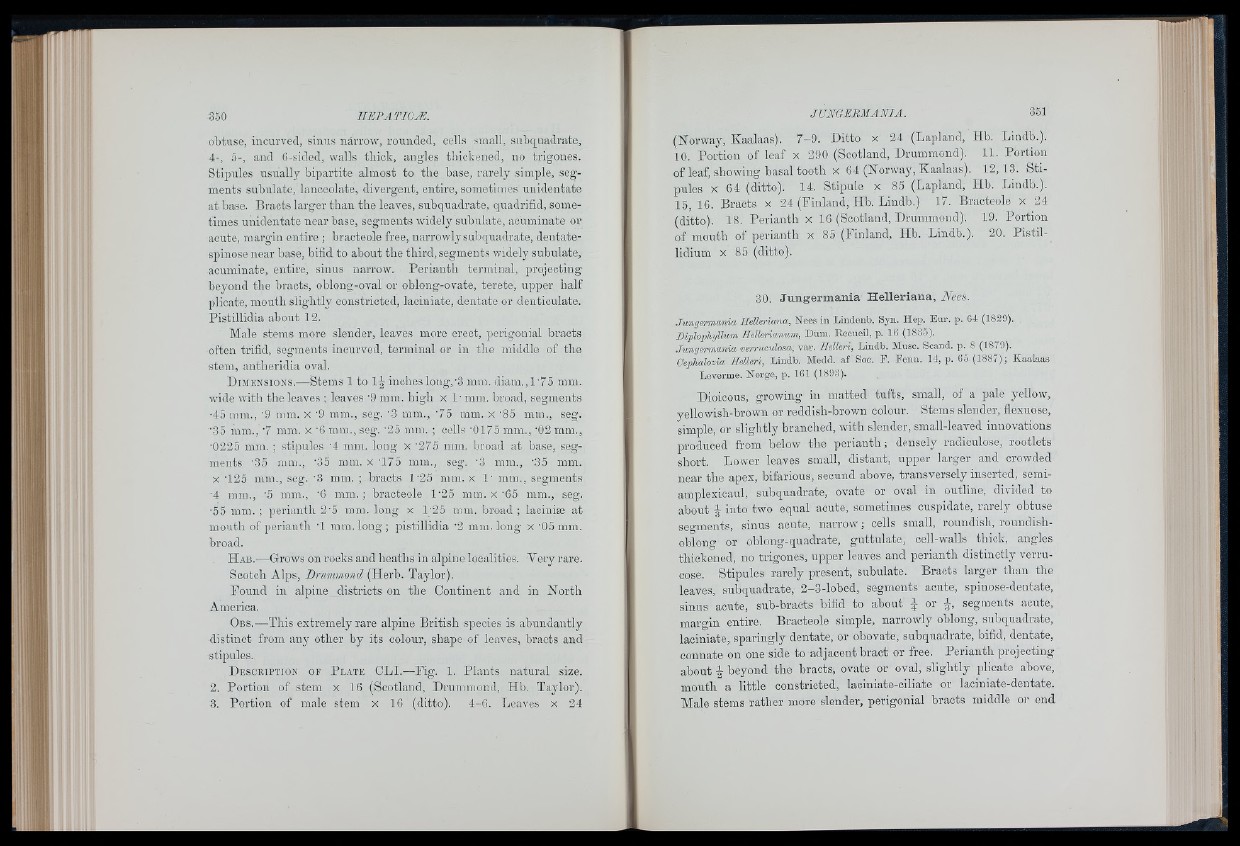
obtuse, incurved, sinus narrow, rounded, cells small, subquadrate,
4-, 5-, and G-sided, walls thick, angles thickened, no trigones.
Stipules usually bipartite almost to the base, rarely simqde, segments
subulate, lanceolate, divergent, entire, sometimes unidentate
at base. Bracts larger than the leaves, subquadrate, quadrifid, sometimes
unidentate near base, segments widely subulate, acuminate or
acute, margin entire ; bracteole free, narrowly suhquadrate, dentate-
spinose near base, bifid to about the third, segments widely subulate,
acuminate, entire, sinus narrow. Perianth tei'ininal, projecting
beyond the bracts, oblong-oval or oblong-ovate, terete, upper half
plicate, mouth slightly constricted, laciniate, dentate or denticulate.
Pistillidia about 12.
Male stems more slender, leaves more erect, perigonial bracts
often trifid, segments incurved, terminal or in the middle of the
stem, antheridia oval.
D imensions.— Stems 1 to inches long,’3 mm. diam., 1 '75 mm.
wide with the leaves ; leaves '9 mm, high x 1- mm. broad, segments
•45 mm., '9 mm. x '9 mm., seg. '3 mm., '75 mm. x '85 mm., seg.
'35 mm,, '7 mm. x 'G mra,, seg. '25 mm. ; cells '0175 mm., '02 mm.,
■0225 mm. ; stipules '4 mm. long x '275 mm. broad at base, segments
'35 mm., '35 mm. x '175 mm., seg. ’3 mm., '35 mm.
x T25 mm., seg. '3 mm. ; bracts 1'25 mm.x 1' mm., segments
'4 mm., '5 mm., 'G nim. ; bracteole 1’25 mm. x '65 mm., seg.
•55 mm. ; perianth 2'5 mm. long x 1;25 mm. broad; laciniæ at
mouth of perianth '1 ram. long; pistillidia '2 mm. long x '05 mm.
broad.
H a b .— Grows on rocks and heaths in alpine localities. Very rare.
Scotch Alps, Drummond (Herb. Taylor).
Pound in alpine districts on the Continent and in North
America.
O b s .—This extremely rare alpine British species is abundantly
distinct from any other by its colour, shape of leaves, bracts and
stipules.
D escription oe P l.ate CLI.—Pig. 1. Plants natural size.
2. Portion of stem x 16 (Scotland, Drummond, Hb. Taylor).
3. Portion of male stem x 16 (ditto). 4-6. Leaves x 24
I
(Norway, Kaalaas). 7-9. Ditto x 24 (Laqdand, Hb. Lindb.).
10. Portion of leaf x 290 (Scotland, Drummond). 11. Portion
of l e a f , showing basal tooth x 64 (Norway, Kaalaas). 12,13. Stipules
X 64 (ditto), 14. Stipule x 85 (Lapland, Hb, Lindb.).
15, 16. Bracts x 24 (Finland, Hb. Lindb.) 17. Bracteole x 24
(ditto). 18. Perianth x 16 (Sootl'and, Drummond). 19. Portion
of mouth of jiei'ianth x 85 (Finland, Hb. Lindb.). 20. Pistillidium
X 85 (ditto).
30. Jungermania Helleriana, Nees.
.Tungermania Helleriana, Xees in Lindenb. Syn. Hep. Eur. p. 64 (1829).
Diplophyllum Ilellerianum, Dum. Eecueil, p. 16 (1833).
Jungermania verruculosa, var. llelleri, Liudb. Muse. Scand. p. 8 (1879).
Cephalozia llelleri, Lindb. Medd. af Soc. F. Fenn. 14, p. 65 (1887); Kaalaas
Leverme. Norge, p. 161 (1893).
Dioicous, growing in matted tufts, small, of a pale yellow,
yellowish-brown or reddish-brown colour. Stems slender, flexuose,
simple, or slightly branched, with slender, small-leaved innovations
proLoed from below the perianth; densely radiculose, rootlets
short. Lower leaves small, distant, upper larger and crowded
near the apex, bifarious, secund above, transversely inserted, semiamplexicaul,
subquadrate, ovate or oval in outline, divided to
about into two equal acute, sometimes cuspidate, rarely obtuse
seo-ments, sinus acute, narrow; cells small, roundish, roundish-
oblono- or oblong-quadrate, guttulate, cell-walls thick, angles
thickened, no trigones, upper leaves and perianth distinctly verrucose.
Stipules rarely present, subulate. Bracts larger than the
leaves, snbquadrate, 2-3-lobed, segments acute, spinose-dentate,
sinus acute, sub-bracts bifid to about J or -J-, segments acute,
margin entire. Bracteole simple, narrowly oblong, subquadrate,
laciniate, sparingly dentate, or obovate, snbquadrate, bifid, dentate,
connate on one side to adjacent bract or free. Perianth projecting
about J beyond the bracts, ovate or oval, slightly qilicate above,
mouth a little constricted, laciniate-ciliate or laciniate-dentate.
Male stems rather more slender, perigonial bracts middle or end